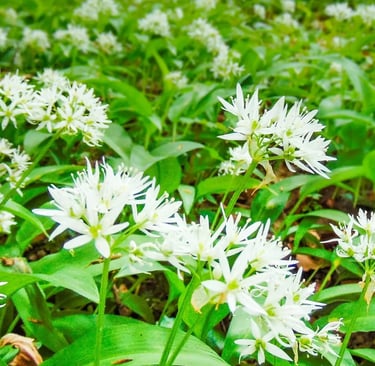Bear's garlic: Where to find it ?
Wild garlic is a wild plant with recognised aromatic and medicinal properties. Also known as wild garlic or wood garlic, this emblematic species of European flora is attracting growing interest from lovers of cooking and phytotherapy. But where can you get hold of this very special plant? Let's take a look at the different sources.
QUESTIONS/ANSWERS
What is wild garlic ?
Bear's garlic, scientifically known as Allium ursinum, is a perennial herb belonging to the Amaryllidaceae family. Native to Europe and temperate Asia, it is particularly common in cool, damp undergrowth, where it often forms vast green mats in spring.
Its elongated leaves and white umbellate flowers make it easily recognisable. But it is above all for its bulb and edible leaves that wild garlic is appreciated. In fact, this plant has interesting aromatic, medicinal and nutritional properties.
Where to buy wild garlic ?
Despite its culinary and medicinal value, wild garlic is still a relatively unknown plant among the general public. However, there are several ways of obtaining it, both in the wild and commercially.
Wild picking.
Collecting wild garlic in the wild is an age-old practice, but one that needs to be supervised and carried out with care. This plant grows naturally in cool, damp undergrowth, often in wooded areas.
To harvest wild wild garlic, it is important to identify the plant correctly (not to confuse it with toxic species such as lily of the valley) and to follow a few rules:
Find out about local regulations on picking wild plants
Avoid areas likely to be polluted (roadsides, industrial zones, etc.)
Harvest in moderation, leaving enough plants to ensure the regeneration of the population
Respect the environment and avoid damaging natural habitats
Wild picking allows you to obtain fresh, high-quality wild garlic, while helping to preserve this emblematic plant.
Short-distance purchasing.
If picking is not an option, you can also buy wild garlic from local producers or distributors specialising in short distribution channels.
In many regions, farmers or professional harvesters grow or harvest wild garlic, which they sell directly at markets, in farm shops or via online platforms.
These sources of supply will guarantee you fresh, local, quality produce, while supporting a more sustainable economy.
You can buy it in supermarkets and hypermarkets.
Although less common, you can also find wild garlic in some supermarkets and hypermarkets, particularly in the fruit and vegetable or delicatessen sections.
However, the availability and quality of these products may vary. Wherever possible, it's best to use short supply routes.
Advice on storage and use.
Once you've got your wild garlic, it's important to know how to store and use it properly to preserve all its properties.
Fresh bulbs and leaves can be stored for a few days in the fridge, wrapped in a damp cloth. They can also be frozen for longer storage.
In cooking, wild garlic can be eaten raw (in salads, pesto, spreads, etc.) or cooked (in stews, soups, omelettes, etc.). Its leaves and bulb add a delicate garlicy flavour and can replace traditional garlic in many recipes.
Bear's garlic can be used medicinally as an infusion, capsule or mother tincture, always in consultation with a qualified health professional.
Conclusion.
Although still little known to the general public, wild garlic is a wild plant with many virtues that can be obtained in a variety of ways. Whether you pick it responsibly, buy it locally or buy it from supermarkets, everyone can easily incorporate this aromatic and beneficial plant into their diet or natural medicine.
Rich in active compounds, wild garlic deserves all our attention and can become a precious ally in preserving our health naturally. So don't hesitate to discover and adopt it!
If you liked this article. Don't hesitate to read the full article on wild garlic. Click here


